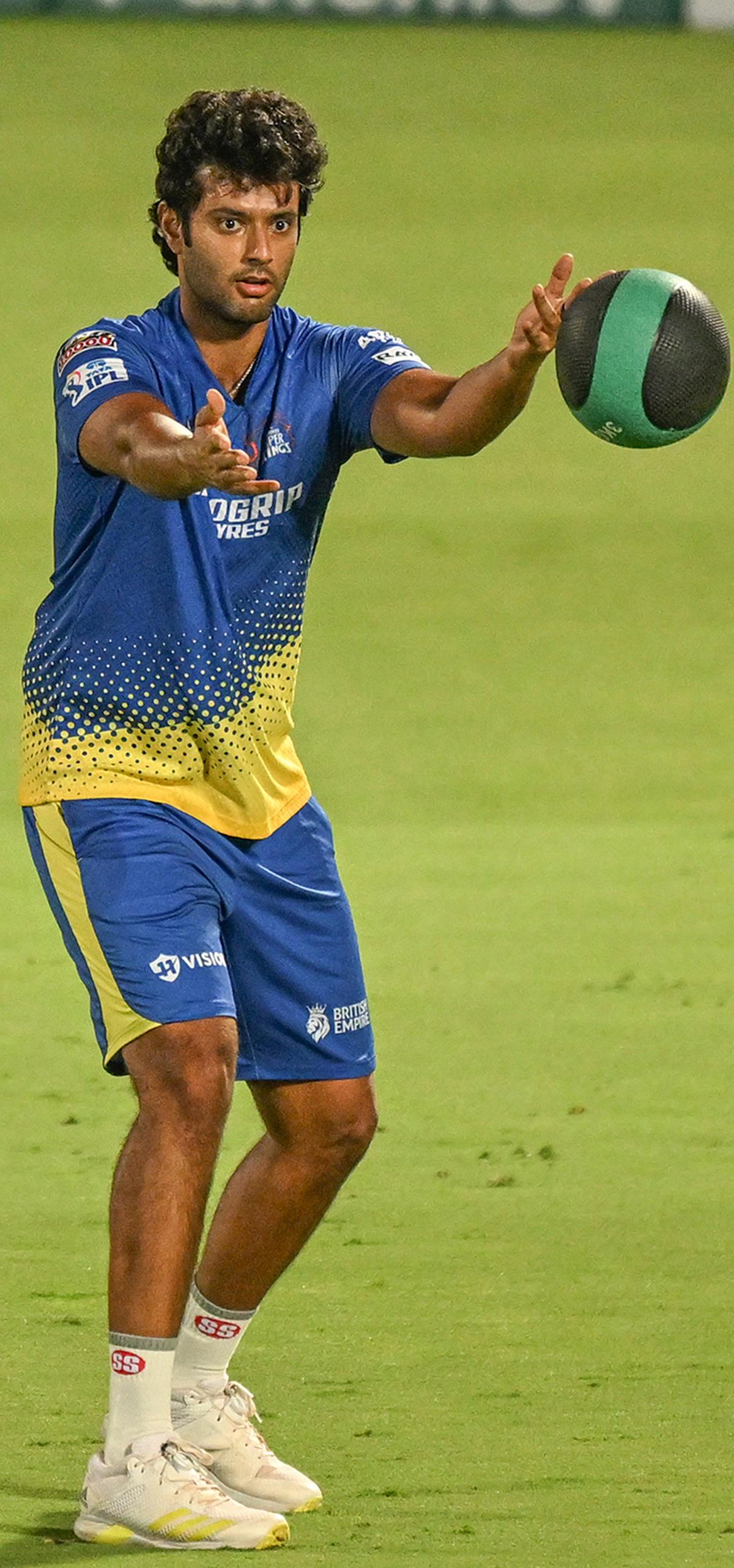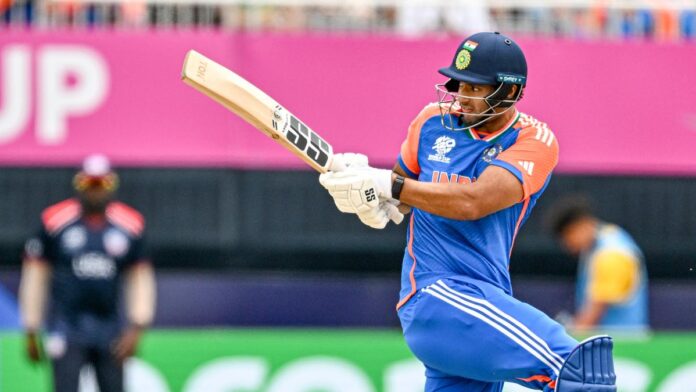“Woh shot dekha? Reminded you of Yuvi, didn’t it?”
Ravi Shastri, then India’s head coach, made this observation at Auckland’s Eden Park on 26 January 2020, seconds after Shivam Dube had clubbed Tim Southee over long-on for the six that sealed victory in the second of five Twenty20 Internationals.
It was the left-handed Mumbaikar’s 10th T20I; he had announced himself with an unbeaten 30-ball 54 just a month and a half previously, against West Indies in Thiruvananthapuram. Dube was 27 at the time, with a long future ahead of him in white-ball cricket owing to his propensity to hit the ball a long way and the rare tag of a potential all-rounder who could also bowl medium-pace.
Few knew at the time, not even the prescient Shastri, that following the end of that New Zealand series, Dube wouldn’t play international cricket for three and a half years. The early promise was studiously ignored, the comparisons with ‘Yuvi’, aka Yuvraj Singh, quickly forgotten. Dube threatened to figure in the list of the could-have-beens, lumbering from IPL franchise to franchise and not really setting the domestic stage alight, either.
Turning point
Then, Chennai Super Kings happened. At the IPL mega auction in 2022, the multiple-times former champions dished out ₹4.40 crores for the man from Mumbai, who had moved from Royal Challengers Bangalore to Rajasthan Royals with limited success. The sceptics tut-tutted, amazed that CSK would invest so much in someone who had done so little. Hardly did they know that a turning of the corner was imminent.

Chennai Super Kings’ Shivam Dube during a training session ahead of the Indian Premier League (IPL) 2024, between CSK and DC at ACA-VDCA stadium in Visakhapatnam, Saturday, March 30, 2024. Photo K.R Deepak / The Hindu
| Photo Credit:
DEEPAK KR
Mahendra Singh Dhoni and Stephen Fleming assigned Dube a specific role – the takedown of spin in the middle overs. They gave him a stable position in the upper middle order, infused in him the confidence and belief that he could destroy the best with his power and timing. The backroom staff spent hours working on his mind, and even more hours getting his range-hitting prowess up and running.
The results were spectacular; Dube responded with 289 runs at an average of 28.90 and a strike-rate of 156.22. When he backed that up with 418 runs the following season at corresponding numbers of 38.00 and 158.33, it was impossible for the India selectors to keep looking beyond him.
Thus began Dube’s second coming in international cricket, with a ‘second’ team against Ireland in Malahide in August 2023. A month and a half later, he was part of the gold medal-winning team at the Hangzhou Asian Games and while he hadn’t had too many chances to showcase his ball-striking skills, combined returns of 47 runs (undefeated) in 35 balls in those two events since his comeback earned him a shot at Afghanistan at the start of this year.
Dube responded in spectacular style, backing up an unbeaten 60 in Mohali with 63 not out in Indore. Out of nowhere, he had stormed into contention for a place in the T20 World Cup in the Americas, locked in a battle for the middle-order slot/finisher’s role with Rinku Singh, the exuberant youngster from Uttar Pradesh and Kolkata Knight Riders.
IPL 2024 wouldn’t seal the deal, but it wouldn’t hurt either. Dube made the most of getting enough opportunities to bat and reiterate his power-hitting, while Rinku was unfortunate that between Phil Salt, Sunil Narine and the two Iyers, skipper Shreyas and Venkatesh, hardly allowed him a look-in. That was that, Dube was on the flight to North America with Rinku in tow as one of the reserves.
The introduction of the Impact Player is one of the more divisive topics in IPL history. Originally designed to bolster bowling strengths and ensure that teams no longer had to patch together a makeshift fifth option, it has had the exact opposite effect, with batters emboldened to keep firing away even when early wickets have fallen in a clutch because of the insurance of an additional batting choice.
In many ways, as even Rohit Sharma has pointed out, it has stunted the growth of the Indian all-rounder. Where, in the past, a Venkatesh Iyer broke into the national team because he could also bowl medium-pace, there was no need for his bowling skills to be utilised anymore. Ditto for Dube; in IPL 2023, when the Impact Player concept first reared its head, he didn’t bowl at all and last year, his appearance at the bowling crease was limited to six deliveries.
There is no Impact Player in international cricket, but that didn’t prevent India from investing in Dube. After all, they did have Hardik Pandya, the premier pace-bowling all-rounder. Dube was picked as a pure batter, and he didn’t disappoint at the World Cup, where he showcased another facet of his batting – the ability to bat according to the situation.
That was on a decidedly dodgy surface at the Nassau County International Cricket Stadium in New York, the home of incalculable surfaces during the World Cup. India was all but through to the Super Eights but woe betide the team if it lost to United States! The latter had already conquered Pakistan in the Super Over and was eyeing its second big scalp on the bounce, defending a meagre 110 for eight with a desperation that beggared belief.
Saurabh Netravalkar, formerly of Mumbai and India Under-19, packed off Rohit and Virat Kohli in his first spell, Pakistan-born Ali Khan accounted for Rishabh Pant. At 39 for three, India was in a pickle; 72 needed off 75 with seven wickets in hand might have appeared a walk in the park, but it was anything but. The ball did things as if it had a mind of its own, as if it enjoyed making the best look mediocre, as if there was a perverse pleasure to be had in driving batters ragged. Even Suryakumar Yadav, then the No. 1 T20I batter in the world, couldn’t impose himself on the bowling.
Dube struggled for timing, but didn’t throw it away. He bided his time, aware that India needed him to step up in Suryakumar’s company. The big strokes were put away in cold storage, the ones and twos became the staple diet. By the end, the two Mumbaikars hauled the team home with ten deliveries to spare, Dube’s contribution in the stand of 72 — a measured 31 off 35. One four, one six. Not just a six-hitter, but capable of batting at other gears too.
As the tournament moved solely to the Caribbean for the Super Eights, the pitches got better and the Dube of CSK fame resurfaced – 34 off 24 against Bangladesh, 28 off 22 against Australia and a vital 27 off 16 in the final against South Africa at a time when Kohli went without a boundary for 35 consecutive deliveries. Dube had done what he was picked for – not to score conservative half-centuries but to provide the final kick, the last push that could so often be the difference between victory and defeat.
Further reward, apart from a World Cup winner’s medal, came in the form of a recall to the One-Day International set-up, more than four and a half years after his only 50-over game for the country, against West Indies in December 2019. He made nine off six and went for 68 in his 7.5 overs at Chepauk, with West Indies cantering to an eight-wicket win.
Jettisoned after that misadventure, he is back in the 50-over mix in Sri Lanka. In Friday’s first ODI, he picked up his maiden wicket, Kusal Mendis, trapped in front, and almost took India past the finish line with 25 off 24 after coming in at No. 8. Two nights later, promoted to No. 4, he was transfixed by a ripping leg-break from Jeffrey Vandersay, trapped in front as he played right back and missed the line. Hazy shades of Yuvi there too, Ravi?
Dube’s reintegration with the one-day format must be construed as a middling long-term option, as an insurance for Pandya. Fitness concerns and workload management combined to ensure that India’s T20 captaincy in the wake of Rohit’s retirement was conferred on Suryakumar.
The CSK batter’s return to the ODI landscape must also be viewed through the same prism. He will get his chances to prove his worth, but his permanence will largely depend on Pandya. In any case, until the start of the Champions Trophy in late February, India have just four more ODIs and it’s anyone’s guess which of Dube or Pandya will start its final assignment before that tournament, the three-match home series against England in February.
Dube is a seasoned 31 years old, but he has much work ahead of him, especially when it comes to his fielding and catching. He isn’t the fastest mover on the park nor the most assured catcher, both red flags in modern-day cricket, whether at the international level or below that. Dube isn’t naturally athletic and there’s precious little that can be done about it at this stage of his career, where T20Is will still be his preferred cup of tea.
But if he is desirous of a longer innings in a longer format, the onus is on him to become a better fielding version of himself. He has shown the hunger and the desire with the bat; if he can translate that into other aspects of his cricket, he potentially still has another T20 World Cup (in 2026) in him. At the very least.

